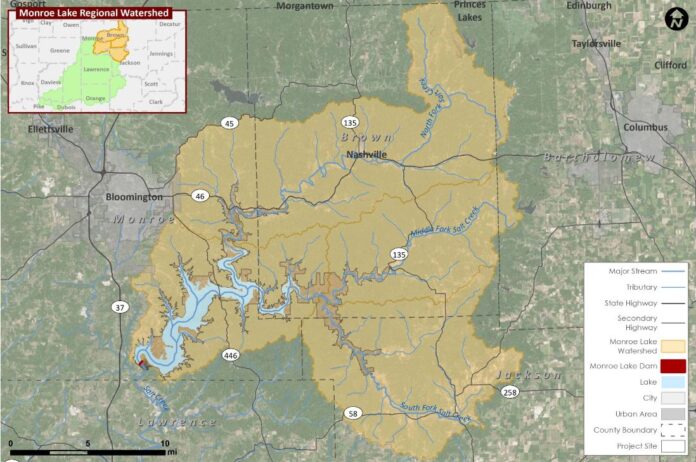By SHERRY MITCHELL-BRUKER, guest columnist
As president and founder of Friends of Lake Monroe, I spoke before the Brown County Commissioners in the summer of 2018 about Lake Monroe and its watershed.
The Lake Monroe watershed encompasses all the land that ultimately drains into Lake Monroe. Fifty-four percent of the Lake Monroe watershed is in Brown County. I talked to the commissioners about the problems in the lake and watershed and asked for their support in applying for a grant to develop a management plan for the lake and its watershed.
After that meeting, a Brown County resident talked with me about her concerns with Lake Monroe. She was worried about E. coli, a bacterium that has been found in Crooked Creek. Her daughter had become ill from E. coli, which she believed was caused by swimming in Crooked Creek. She wanted to know if there was still E. coli in Crooked Creek and if it was safe to swim.
E. coli can cause serious and life-threatening illness in humans. The presence of E. coli is also used as an indicator to monitor the possible presence of other more harmful microbes, such as cryptosporidium, giardia, shigella and norovirus. Some possible sources of fecal contamination include agricultural runoff, wildlife, runoff from areas contaminated with pet manure, inadequate wastewater treatment plants, and on-site septic systems. Heavy precipitation can cause these organisms to be washed into creeks, rivers, streams, or lakes. If this water is swallowed during swimming or used as an untreated source of drinking water, it may cause illness.
In the summer of 2018, Friends of Lake Monroe applied for a grant to take water samples and develop a management plan for the Lake Monroe watershed. The Brown County Commissioners, along with over 30 other private and public stakeholders, wrote a letter of support for our grant application. In November of 2019, the grant was awarded to the Friends of Lake Monroe.
Over the next two years, monthly water samples throughout the watershed will be analyzed for possible pollutants, including E. coli. In addition, we will engage citizen scientists in a “sampling blitz,” collecting water samples at more than 100 sites in a single day to provide a snapshot of the water quality throughout the watershed.
The results of this analysis, along with input from residents, business and government, will be incorporated into a plan to reduce pollution in the lake and watershed.
Pollutants like fertilizers, septic leachate, herbicides, pesticides and erosion from bare soils feed the lake and watershed in unhealthy ways. We need to cut back on all of those unhealthy pollutants and prevent erosion of bare soil throughout the watershed.
Many people think that their small amount of pollution is not significantly harming the lake, but the truth is that all of the actions throughout this 423-square-mile area that feeds the lake are concentrated 25 times in the 16.8-square-mile lake. An action that seems harmless is added to all of the other seemingly harmless actions to create harm.
The Friends of Lake Monroe, the Leagues of Women Voters of Bloomington-Monroe County and Brown County, and many others are working to build a watershed management plan, and we need everyone to do their part in making the plan work.
We are holding a community forum to gather public comments and concerns about the sustainability of Lake Monroe and its watershed. The community forum will be held from 6:45 to 8:30 p.m. on Tuesday, Jan. 14 at the Brown County Public Library.
Come join us and learn more about protecting the Lake Monroe watershed!
Sherry Mitchell-Bruker, a hydrologist, is the founder of Friends of Lake Monroe. She can be reached at [email protected], at friendsoflakemonroe.org or through the Facebook page “Friends of Lake Monroe.”





